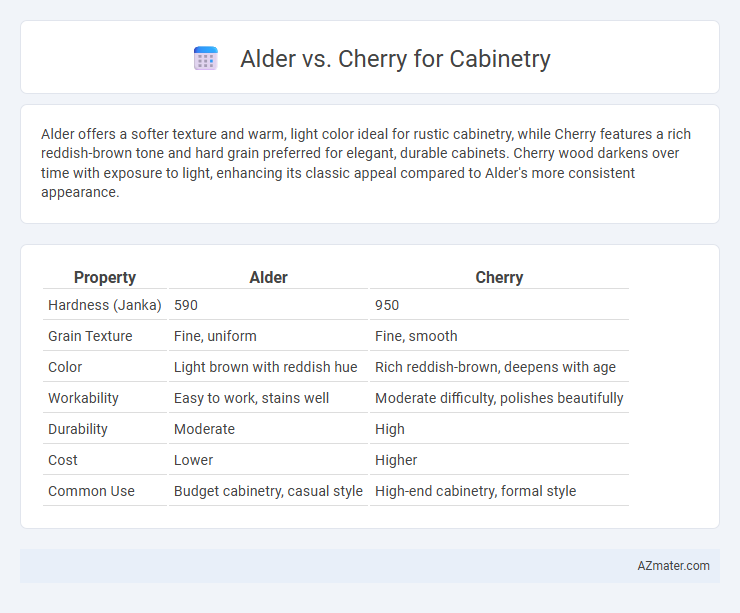Alder offers a softer texture and warm, light color ideal for rustic cabinetry, while Cherry features a rich reddish-brown tone and hard grain preferred for elegant, durable cabinets. Cherry wood darkens over time with exposure to light, enhancing its classic appeal compared to Alder's more consistent appearance.
Table of Comparison
| Property | Alder | Cherry |
|---|---|---|
| Hardness (Janka) | 590 | 950 |
| Grain Texture | Fine, uniform | Fine, smooth |
| Color | Light brown with reddish hue | Rich reddish-brown, deepens with age |
| Workability | Easy to work, stains well | Moderate difficulty, polishes beautifully |
| Durability | Moderate | High |
| Cost | Lower | Higher |
| Common Use | Budget cabinetry, casual style | High-end cabinetry, formal style |
Overview of Alder and Cherry Wood
Alder wood, known for its soft texture and uniform grain, offers a warm, light reddish-brown hue ideal for rustic or casual cabinetry styles. Cherry wood features a fine, smooth grain with a rich, reddish-brown color that darkens over time, providing a luxurious and elegant finish for high-end cabinetry. Both woods are durable and workable, but alder tends to be more affordable and easier to stain, while cherry is prized for its natural beauty and aging characteristics.
Physical Characteristics Comparison
Alder wood features a fine, uniform grain with a smooth texture, making it easy to stain and ideal for a rustic or traditional cabinetry look, while cherry wood boasts a distinct, straight grain with occasional waves and a rich, reddish-brown hue that deepens over time for a luxurious appearance. Alder is softer, ranking about 590 on the Janka hardness scale, providing easier workability but less resistance to dents and scratches compared to cherry, which scores around 950, offering greater durability for high-traffic kitchen spaces. Both woods have good stability, but cherry's natural resistance to warping and shrinking makes it a preferred choice for long-lasting, high-quality cabinetry.
Color and Grain Differences
Alder wood showcases a warm, light brown to reddish hue with a smooth, consistent grain pattern, making it ideal for cabinetry that requires a soft, natural look. Cherry wood features a richer, deeper reddish-brown color that darkens over time, complemented by a fine, straight grain with occasional waves or curls, providing an elegant and classic appeal. The color stability and uniform grain of alder contrast with cherry's evolving patina and distinctive grain variations, influencing the final aesthetic of cabinetry designs.
Durability and Hardness
Alder wood offers moderate durability and a Janka hardness rating around 590, making it softer and more prone to dents compared to Cherry. Cherry wood boasts a higher durability with a Janka hardness of approximately 950, providing better resistance to wear and impact for cabinetry. Cabinetry crafted from Cherry is typically more resilient over time, maintaining its structural integrity in high-use areas.
Workability and Ease of Finishing
Alder wood offers excellent workability due to its softer texture, making it easier to cut, shape, and sand compared to Cherry, which is denser and harder. In terms of finishing, Alder absorbs stains and paints uniformly, allowing for a smooth, consistent appearance, while Cherry develops a rich patina over time but can be more challenging to finish evenly. Both woods respond well to finishing techniques, but Alder is often preferred for projects requiring straightforward, efficient craftsmanship.
Cost and Availability
Alder wood is generally more affordable and widely available compared to cherry, making it a popular choice for budget-conscious cabinetry projects. While cherry offers a richer, deeper color and ages beautifully with a smooth finish, its higher cost and limited availability can be restrictive for some homeowners. Both woods offer durability, but alder's easier sourcing and cost-effectiveness often make it the preferred option for large-scale or cost-sensitive cabinetry installations.
Best Uses in Cabinetry
Alder wood's smooth texture and consistent grain make it ideal for painted or stained cabinetry, providing a warm, rustic appearance perfect for traditional and craftsman-style kitchens. Cherry wood offers a rich, reddish hue that deepens with age, making it a premium choice for elegant, high-end cabinetry that highlights natural wood beauty in formal and classic interiors. Alder excels in affordability and versatility for cabinets, while cherry is preferred for its durability and sophisticated, timeless aesthetic.
Maintenance and Longevity
Alder wood offers softer grain and requires more frequent maintenance due to its susceptibility to dents and scratches, making it ideal for users who prefer refinishing options to maintain appearance. Cherry wood provides superior durability and ages gracefully with a rich patina, ensuring longer-lasting cabinetry with minimal upkeep. Both woods benefit from regular cleaning and protection against moisture to maximize lifespan, but cherry's natural hardness contributes to enhanced resistance over time.
Environmental Impact and Sustainability
Alder wood is generally more sustainable than cherry due to its faster growth rate and abundance, resulting in less environmental strain during harvesting. Cherry trees grow slower and are less widespread, which can contribute to deforestation concerns when managed unsustainably. Choosing alder for cabinetry supports eco-friendly practices by promoting renewable resources and reducing ecological footprints.
Choosing the Right Wood for Your Cabinets
Alder wood offers a smooth texture, rich reddish-brown tones, and affordability, making it ideal for warm, rustic cabinetry. Cherry wood features a tighter grain, deepens in color over time, and provides superior durability, suited for elegant, high-end cabinets. Selecting between alder and cherry hinges on budget, desired aesthetic, and long-term aging preferences for your cabinets.

Infographic: Alder vs Cherry for Cabinetry
 azmater.com
azmater.com